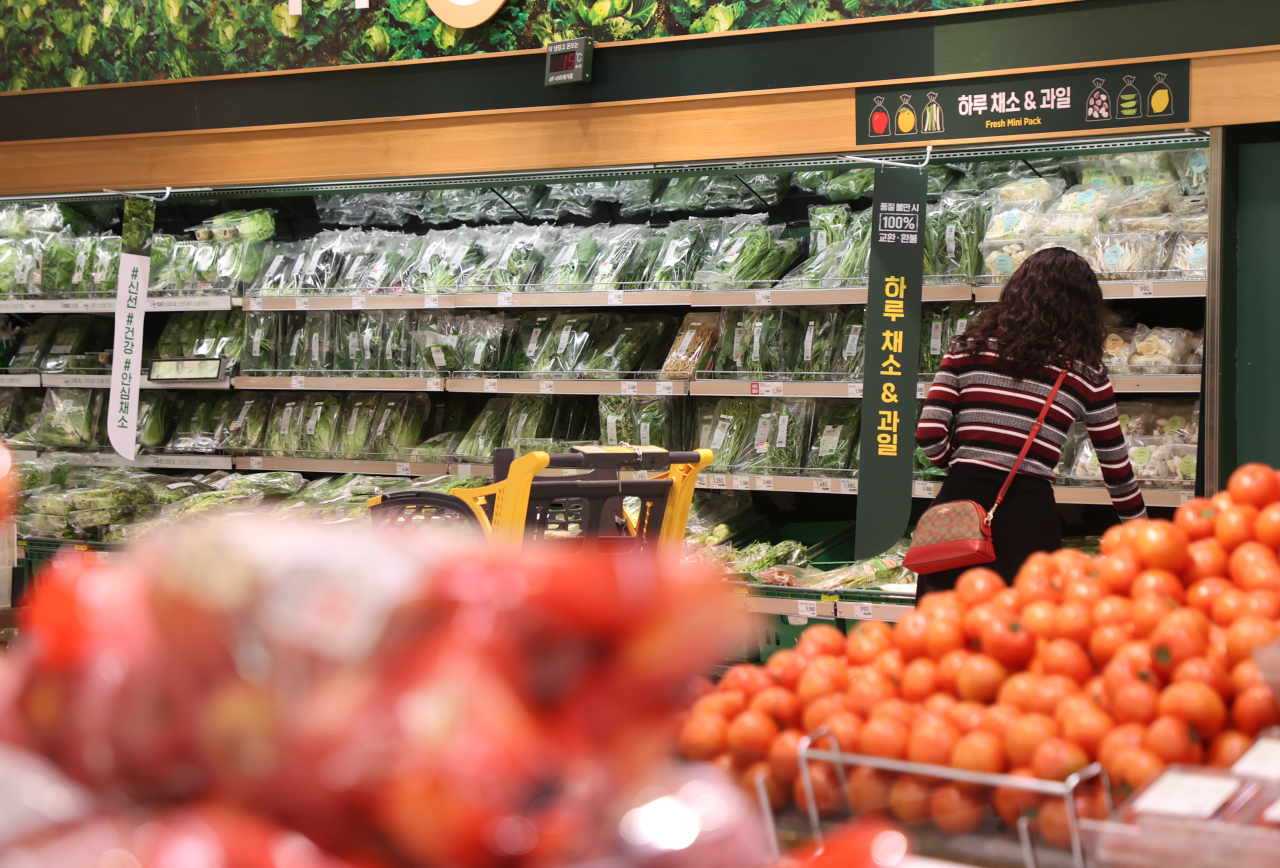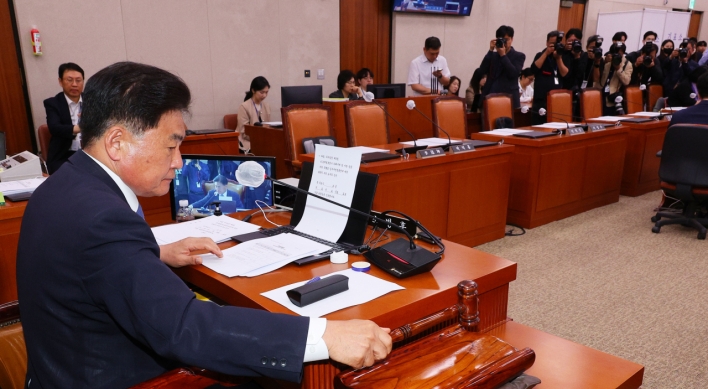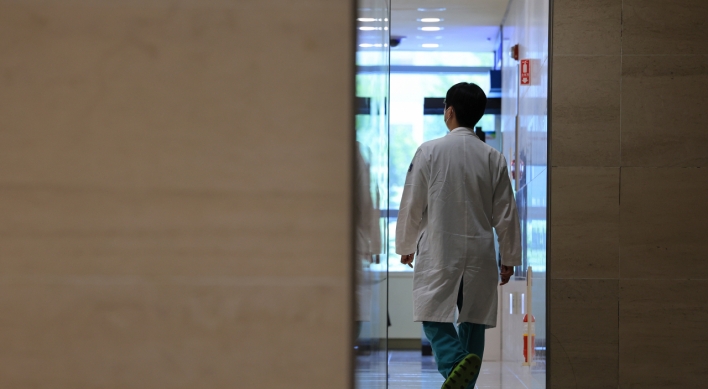
SEJONG -- Korea’s consumer prices climbed the fastest in more than 13 years last month in the wake of a spike in international raw materials prices after Russia’s invasion of Ukraine as well as sharply rising global demand for goods, state data showed Tuesday.
According to Statistics Korea, consumer prices rose 4.8 percent last month, compared to a year earlier. This marked the highest since October 2008, when the same figure of 4.8 percent was reported.
The surge came despite a Bank of Korea benchmark interest rate hike by 25 basis points to 1.5 percent per annum on April 14.
Data showed that a steep increase in consumer prices started in the fourth quarter of 2021: While the growth ranged between 2.3 percent and 2.6 percent between April and September 2021, it ranged between 3.2 percent and 3.8 percent between October 2021 and February 2022.
Though the BOK’s monetary policy committee raised the interest rate in August, November 2021 and January 2022 to tame inflation, the consumer price growth reached a critical level of 4.1 percent in March.
In April, gasoline and diesel prices have led the inflation with an on-year growth of 28.5 percent and 42.4 percent, respectively. The price of liquefied petroleum gas rose by 29.3 percent.
While international crude prices have stopped its sharp advance, the ongoing war between Ukraine and Russia could possibly cause another spike in energy prices. This is one of the main downside risks for the Korean economy.
In the agricultural and livestock segment, a 28.8 percent increase was seen in the price of imported beef, 23 percent in grapes, 17.2 percent in Korean melons, 16.6 percent in chicken and 5.5 percent in pork.
International airfares rose by 16.2 percent, electricity charges by 11 percent, raw fish by 10.9 percent and insurance premiums by 10.3 percent.
“There is a high possibility that consumer prices will continue to grow at a fast pace. (We cannot find) any factor, which could curb the high increase at the current stage,” said a senior official of Statistics Korea.
Among the 17 major cities and provinces in the nation, Gangwon Province topped the list with a 5.9 percent consumer price growth, followed by North Gyeongsang Province with 5.8 percent and South Chungcheong Province with 5.6 percent. The next were Jeju Province and South Jeolla Province at 5.5 percent and North Chungcheong Province at 5.3 percent.
Seoul posted the lowest figure of a 4 percent growth. Gyeonggi Province and Sejong saw consumer prices climb by 4.8 percent and 5 percent, respectively.
Deputy Prime Minister and Finance Minister Hong Nam-ki said “the nation has faced a tough inflationary pressure due to a glitch in global supply of products and the Ukraine-Russia incident.”
He said the government would not spare any effort to stabilize prices, mentioning the recent measure of slashing the fuel tax rate by 30 percent. The tax cut, which started from May 1, is aimed at easing the burden on households from high gasoline prices.
By Kim Yon-se (kys@heraldcorp.com)
According to Statistics Korea, consumer prices rose 4.8 percent last month, compared to a year earlier. This marked the highest since October 2008, when the same figure of 4.8 percent was reported.
The surge came despite a Bank of Korea benchmark interest rate hike by 25 basis points to 1.5 percent per annum on April 14.
Data showed that a steep increase in consumer prices started in the fourth quarter of 2021: While the growth ranged between 2.3 percent and 2.6 percent between April and September 2021, it ranged between 3.2 percent and 3.8 percent between October 2021 and February 2022.
Though the BOK’s monetary policy committee raised the interest rate in August, November 2021 and January 2022 to tame inflation, the consumer price growth reached a critical level of 4.1 percent in March.
In April, gasoline and diesel prices have led the inflation with an on-year growth of 28.5 percent and 42.4 percent, respectively. The price of liquefied petroleum gas rose by 29.3 percent.
While international crude prices have stopped its sharp advance, the ongoing war between Ukraine and Russia could possibly cause another spike in energy prices. This is one of the main downside risks for the Korean economy.
In the agricultural and livestock segment, a 28.8 percent increase was seen in the price of imported beef, 23 percent in grapes, 17.2 percent in Korean melons, 16.6 percent in chicken and 5.5 percent in pork.
International airfares rose by 16.2 percent, electricity charges by 11 percent, raw fish by 10.9 percent and insurance premiums by 10.3 percent.
“There is a high possibility that consumer prices will continue to grow at a fast pace. (We cannot find) any factor, which could curb the high increase at the current stage,” said a senior official of Statistics Korea.
Among the 17 major cities and provinces in the nation, Gangwon Province topped the list with a 5.9 percent consumer price growth, followed by North Gyeongsang Province with 5.8 percent and South Chungcheong Province with 5.6 percent. The next were Jeju Province and South Jeolla Province at 5.5 percent and North Chungcheong Province at 5.3 percent.
Seoul posted the lowest figure of a 4 percent growth. Gyeonggi Province and Sejong saw consumer prices climb by 4.8 percent and 5 percent, respectively.
Deputy Prime Minister and Finance Minister Hong Nam-ki said “the nation has faced a tough inflationary pressure due to a glitch in global supply of products and the Ukraine-Russia incident.”
He said the government would not spare any effort to stabilize prices, mentioning the recent measure of slashing the fuel tax rate by 30 percent. The tax cut, which started from May 1, is aimed at easing the burden on households from high gasoline prices.
By Kim Yon-se (kys@heraldcorp.com)









![[Kim Seong-kon] Democracy and the future of South Korea](http://res.heraldm.com/phpwas/restmb_idxmake.php?idx=644&simg=/content/image/2024/04/16/20240416050802_0.jpg&u=)








![[Today’s K-pop] Zico drops snippet of collaboration with Jennie](http://res.heraldm.com/phpwas/restmb_idxmake.php?idx=642&simg=/content/image/2024/04/18/20240418050702_0.jpg&u=)